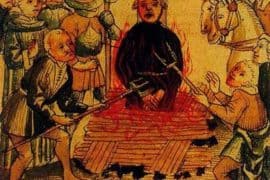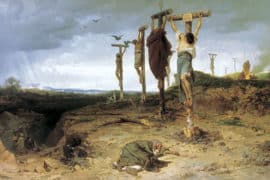My wife Lori often offers comments on my various blog posts, articles, and papers, as one “outside the field,” so to speak. Her field is English Literature but more often than not she sees things that I have missed. Sometimes we who are the so-called “experts” in our fields are too close and miss the forest for the trees.

For example, she was reading my paper “One, Two, or Three Messiahs: Dynastic and Priestly Pedigrees from the Maccabees to Masada,” and she made a most interesting observation. Given the notion of the three figures–with Jesus’ disciples asking about sitting at his “right and left hand” in his glorious kingdom, isn’t it likely that the Romans intended the two others crucified with Jesus, one on the right, the other on the left, to be a way of mocking him as “King of the Jews”? We know this idea is exceptionally wide-spread in Jewish texts of the period, including the more recently discovered, Dead Sea Scrolls. You can find a compilation of the major sources here.
Anyway, notice carefully the language of these two passages in Mark:
And with him they crucified two brigands, one on his right and one on his left.(Mark 15:27)
And they said to him, “Grant us to sit, one at your right hand and one at your left, in your glory.” (Mark 10:37)
It is hard to miss the parallel between these verses in Mark. It was as if the Romans would be saying, Behold your King! He is “reigning” on a cross, with his vice-regents at his right and left hand in his “glory.” Thus the mocking salutations (Hail King of the Jews!) and the pantomine (reed scepter, crown of thorns, and purple robe), are carried out just before Jesus is led out to be crucified (Mark 15:16-20). Although these two men are commonly described as “thieves” in our English translations that is most misleading. The Greek word, lestes(ληστής), is regularly used by Josephus, a contemporary historian, to mean a “brigand” or revolutionary, so it is particularly fitting given this parody of a “royal” court. Mark also notes that Barabbas, who was released by Pontius Pilate instead of Jesus, had been arrested for murder “in the insurrection” (στάσις). Many of my readers will remember the influential study of by S.G.F. Brandon, Jesus and the Zealots: A Study of the Political Factor in Primitive Christianity, published in 1967. Whether one agrees with all of Brandon’s conclusions, and many do not, his penetrating analysis is invaluable and has served as an important contribution to the field of Christian origins. Brandon was convinced that “the insurrection,” alluded to in Mark, was connected some of the activities of Jesus in the Herodian Temple earlier that week.
Regardless of that point I found this idea of the two crucified with Jesus as part of his “mocking” immediately compelling. Clearly, in Mark’s account of the scene before Pilate, Jesus is center stage and the sole object of deliberation. The two crucified with him are only mentioned in Mark 15:27 after Jesus’ crucifixion is reported and immediately when we are told “And the inscription of the charge against him read, “The King of the Jews”–clearly in mockery! In other words, they are mentioned in juxtaposition to this mocking. Mark surely knows his phrasing of “one on his right hand and one on his left” is an echo of his earlier references in 10:37. Norman Perrin, my teacher at the University of Chicago, often pointed out this and other such parallels in Mark. However, I have never heard the scene connected to “mocking Jesus” in the specific way this notion of “three Messiahs” might imply.
Thomas Schmidt has convincingly written about another aspect of Mark’s crucifixion narrative that well might fit into Mark’s portrayal of the scene, namely that the elements he emphasizes are intended to both echo and mirror the Triumphal march of a Roman conquerer, see his summary article in Bible Review “Jesus’ Triumphal March to Crucifixion,” Bible Review 13, no. 1 (1997): 30–37 and his more extensive academic article, “Mark 15:16-32: The Crucifixion Narrative and the Roman Triumphal Procession,” New Testament Studies, vol. 41, 1995, pp. 1-18.
If you couple all of this with the view, which I hold, that the place of crucifixion was the Mt. of Olives, to the east of the Old City, the mockery becomes all the more poignant. The Mt. of Olives is the place of “triumph,” from which conquerers and kings for centuries have viewed the city of Jerusalem. How ironic to see Jesus and his kingly “entourage,” dying on crosses right in front of the eastern Golden Gate of the City through which the Messiah and his supporters were to enter in triumph.









Comments are closed.